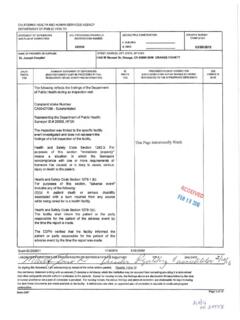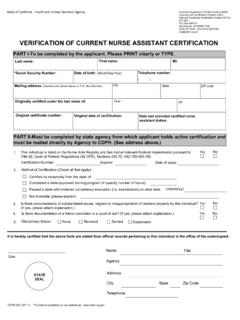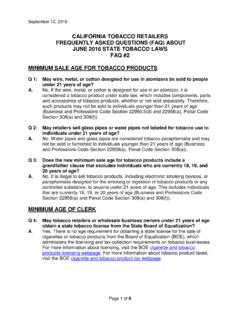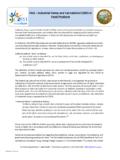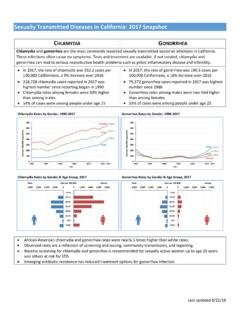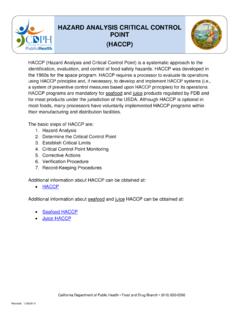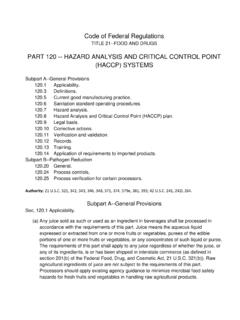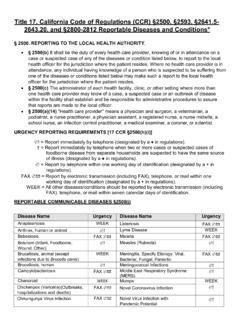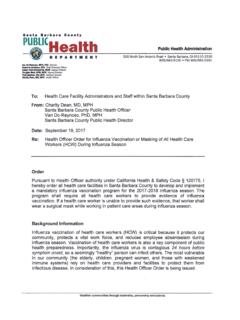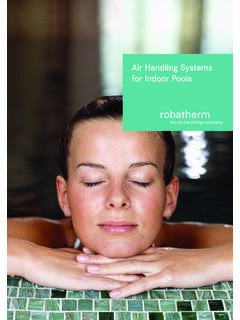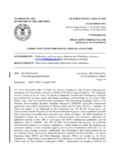Transcription of Molds in Indoor Workplaces: Fact Sheet for Workers and ...
1 Molds in Indoor Workplaces orkplaces Molds are forms of fungi that are found indoors and outdoors. You are exposed to them daily in the air you breathe. Sometimes Molds grow excessively inside your workplace and can cause different types of illnesses. Most Workers will not be affected by Molds . Some Workers have symptoms like those of hay fever and the common cold, but they can last for longer periods. Molds can also aggravate asthma. In addition, some people in wet or moldy buildings may have flu-like symptoms. Most health problems are temporary and can be controlled by limiting exposure to Molds . H ow do I know I am H ow do I get exposed being exposed to Molds to Molds ? at work? Molds produce seed-like spores that are small enough to travel through the air. You can breathe Molds need moisture and a food source (organic in spores or come into contact with them. material). Molds can be any color, including Sometimes Molds also produce chemicals called white, orange, green, brown, or black.
2 Even if mycotoxins, which are attached to the spores and you cannot see any Molds , you may notice a other parts of the mold. You may be exposed to mildew or earthy smell. They may be found mycotoxins at the same time you are exposed to indoors on wet/damp walls, carpets, ceilings, or Molds . Mycotoxins are produced only under certain behind wallpaper, as well as in heating, ventila environmental conditions. tion, and air conditioning (HVAC) systems. Indoor moisture leading to the growth of Molds and other micro-organisms may come from flooding, leaks, high humidity, and steam. H ow can Molds affect Symptoms also can indicate that you are my health? exposed to Molds at work. See Health Effects Molds can cause allergic reactions, fungal of Mold Exposure on page 3. If you have infections, and other health effects. Most Workers , symptoms, observe when they occur. They may however, will have no reaction at all when be work-related if they worsen when you are at exposed to Molds (see page 3).
3 Some Workers work, and disappear or lessen at home or on have underlying health conditions that make weekends, or during vacations. The onset of them more sensitive to effects of mold exposure. symptoms depends on your individual reaction to Molds . Allergic reactions, similar to common pollen or animal allergies, are the most common health FACT effects of Molds . Allergic and toxic illnesses can be treated by getting rid of the mold exposure. Your doctor may also prescribe medication to Sheet control symptoms. Continued inside . HESIS. HAZARD EVALUATION SYSTEM & INFORMATION SERVICE. California Department of Public Health Occupational Health Branch 850 Marina Bay Parkway, Bldg. P, 3rd Floor, Richmond, CA 94804. 510-620-5757 NOVEMBER 2005 California Department of Public Health California Department of Industrial Relations In almost all cases of allergic or other illnesses, If you have symptoms see a doctor.
4 If the symptoms are temporary. However, a small possible, go to an occupational health clinic. Take percentage of people may experience longer this factsheet in to show your doctor, and refer to recovery times. HESIS if there are further questions (see Resources'). If your illness is work-related, your doctor may rec . Fungal infections of internal organs are rare. They ommend your removal from the workplace and you require immediate medical attention and treatment. may be eligible for Workers ' compensation benefits. Make sure your doctor fills out a Doctor's First The symptoms described on page 3 for mold Report of Occupational Injury or Illness (DFR), a exposure can also be due to other causes such as form necessary for a successful claim. bacterial or viral infections, or other allergies. Therefore, it is important to tell your doctor if you Clean up mold contamination. Mold should are concerned about exposure to Molds .
5 If possible, be removed right away. No one with symptoms, have your doctor refer you to, or consult with, an or with a higher likelihood of mold-related illness occupational medicine physician to help determine (see box, page 3), should participate in mold if the illness is work-related. An occupational removal. medicine physician can also help identify other workplace conditions that could be related to Focus on fixing the problem, not testing for your symptoms. mold. A thorough investigation should reveal all sources of mold and moisture. Environmen . tal sampling is usually unnecessary, since all types of Molds should be eliminated. W hat do I do about Scrub hard surfaces (tile, concrete, vinyl, undamaged wood) with ordinary household Molds in the workplace? cleaning products. Bleach is not necessary. Use waterproof gloves. There are no standards to say how much mold is hazardous to your health.
6 There should not be Moldy porous materials (carpet, ceiling tile, visible mold growth or strong moldy odors in wallboard, softened wood) usually require the workplace. removal and replacement. For extensive removal jobs (greater than 30 square feet), Report mold problems. If you see or smell HESIS recommends using a contractor specializ . mold, or if you or others are experiencing mold- ing in this kind of work. There is no state related symptoms, report it so the problem can be license specifically for mold removal or cleanup. investigated. You may need to tell your employer, supervisor, health and safety officer, union Ensure that Workers who remove moldy materials use gloves, eye protection, coveralls, representative, or school board. Find out whether head and shoe covers, and properly fitted co- Workers are experiencing any of the listed respirators. See the recommended respiratory symptoms. See if a particular office, floor, or area protection program (Title 8, California Code is affected.)
7 Your workplace Injury and Illness of Regulations, Section 5144). Choose N-95. Prevention Plan (Title 8, California Code of respirators (not dust masks) in most situations. Regulations, Section 3203) must describe a Make sure mold removal Workers are trained procedure for employees to report hazards to the about dust control methods, use of personal employer. Your employer must correct uncontrolled protective equipment, and health risks. Indoor accumulation of water that may cause mold. (Title 8, California Code of Regulations, Section Avoid using toxic chemicals. Fungicides and 3362). Cal/OSHA enforces these regulations (see disinfectants are rarely appropriate, and may page 4). endanger building occupants. Don't use ozone generators; ozone can harm your lungs. Mold- resistant paints may contain toxic additives. No What about Stachybotrys? chemical can substitute for regular cleaning. See back page Avoid exposure during mold cleanup.
8 The highest exposure to mold often occurs during cleanup. You may need to temporarily leave work 2. Health Effects of Mold Exposure ALLERGIC. q Dermatitis Red itchy skin and/or rash. REACTIONS Asthma May be aggravated or caused by exposure to q mold, resulting in acute attacks of coughing, wheezing, and q shortness of breath. Reactions usually occur within minutes q after exposure, and may repeat 6-10 hours later. Allergic rhinitis or Hypersensitivity pneumonitis sinusitis Similar to (extrinsic allergic alveolitis) Involves hay fever or the the lungs and body. Symptoms include common cold, but over tightness in the chest, difficulty breathing, an extended period of cough, fever, and muscle aches. Reactions time. Symptoms include occur 6-8 hours after exposure. RARE OTHER. a runny nose, nasal EFFECTS. or sinus congestion, irritated or red eyes, FUNGAL. q irritated or scratchy INFECTIONS. throat, and cough.
9 Reactions occur quickly Reported symptoms in damp buildings q after exposure to Molds . include fatigue, headache, fever, muscle q ache, difficulty concentrating and mood changes. The cause of these symptoms is Invasive pulmonary Aspergilloma (formed not completely understood. aspergillosis Only in a pre-existing healed occurs in the severely lung abscess) Symptoms immunocompromised. include cough, coughing Symptoms include up blood, and weight pneumonia plus fever, loss. RARE. bone pain, chills, headache, and weight loss. RARE Workers with a higher likelihood of mold-related illness include those who: Most people will have no reaction Have other allergies at all when exposed to Molds . Have existing respiratory conditions including asthma or other lung diseases Are moderately immunocompromised (such areas where cleanup is occurring, especially if you as diabetic) or severely immunocompromised have symptoms or underlying medical conditions (have AIDS or leukemia, receiving chemo- that increase your risk of mold-related illnesses.)
10 Therapy, or are organ transplant recipients). Eliminate and control the source of Are elderly moisture. As long as moisture is present the mold will return, so the source of the moisture must be eliminated and the building properly maintained. unsuccessful. You and your doctor should explore other possible causes of illness. If there are other Monitor symptoms after cleanup. If Indoor air quality problems or the cleanup was not the symptoms persist after cleanup, they may not adequate, your employer may need professional be related to Molds , or the cleanup effort was assistance.. 3. RESOURCES. ORGANIZATIONS PUBLICATIONS. HESIS can answer questions about the health Workers ' Compensation in California: A. effects of Molds and other workplace hazards for Guidebook for Injured Workers from California California Workers , employers, and health care Department of Industrial Relations. English: professionals, call toll-free (866) 282-5516.
